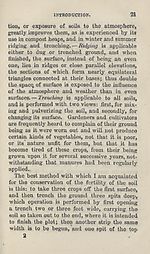Occupations > Abercrombie's improved practical gardener; with a monthly calendar for the flower garden
(24)
Download files
Complete book:
Individual page:
Thumbnail gallery: Grid view | List view

20
INTRODUCTION.
does not depend alone on the quantity in the soil,
but in the number of absorbing fibres. The
more the soil is pulverized the greater is the
increase of absorbing fibres, consequently the
more vigorous does the plant become. Upon the
same principle, pulverization is of advantage, not
only previous to solving and planting, but is
found considerably so during the progress of veg¬
etation, when applied in the intervals among the
plants while the crop is standing. In the last
case it may be considered to operate by way of
pruning, as cutting off the ends of the extending
fibres causes them to put out numerous others,
thus increasing the number of mouths or feeders,
whereby a greater quantity of food is taken up to
the support of the plant. The increase of the
number of fibres is as the inter-pulverization, but
it must be considered that the strength of the
vegetable, in consequence of this multiplicity of
fibres, depends very much on the quantity of
food in the soil; many mouths are but of little
use when there is little or nothing to eat, and it
would be in vain to suppose (as some have done)
that pulverization alone would be sufficient to
promote and support vegetation.
The depth of pulverization depends in a great
measure upon the nature of the soil. In rich
clayey soils it can hardly be too deep, for when
the roots of vegetables are deep they are not so
liable to be injured either by drought or excess
of rain.
It is well known to most cultivators that sera*
INTRODUCTION.
does not depend alone on the quantity in the soil,
but in the number of absorbing fibres. The
more the soil is pulverized the greater is the
increase of absorbing fibres, consequently the
more vigorous does the plant become. Upon the
same principle, pulverization is of advantage, not
only previous to solving and planting, but is
found considerably so during the progress of veg¬
etation, when applied in the intervals among the
plants while the crop is standing. In the last
case it may be considered to operate by way of
pruning, as cutting off the ends of the extending
fibres causes them to put out numerous others,
thus increasing the number of mouths or feeders,
whereby a greater quantity of food is taken up to
the support of the plant. The increase of the
number of fibres is as the inter-pulverization, but
it must be considered that the strength of the
vegetable, in consequence of this multiplicity of
fibres, depends very much on the quantity of
food in the soil; many mouths are but of little
use when there is little or nothing to eat, and it
would be in vain to suppose (as some have done)
that pulverization alone would be sufficient to
promote and support vegetation.
The depth of pulverization depends in a great
measure upon the nature of the soil. In rich
clayey soils it can hardly be too deep, for when
the roots of vegetables are deep they are not so
liable to be injured either by drought or excess
of rain.
It is well known to most cultivators that sera*
Set display mode to:
![]() Universal Viewer |
Universal Viewer | ![]() Mirador |
Large image | Transcription
Mirador |
Large image | Transcription
| Antiquarian books of Scotland > Occupations > Abercrombie's improved practical gardener; with a monthly calendar for the flower garden > (24) |
|---|
| Permanent URL | https://digital.nls.uk/121881507 |
|---|
| Description | Thousands of printed books from the Antiquarian Books of Scotland collection which dates from 1641 to the 1980s. The collection consists of 14,800 books which were published in Scotland or have a Scottish connection, e.g. through the author, printer or owner. Subjects covered include sport, education, diseases, adventure, occupations, Jacobites, politics and religion. Among the 29 languages represented are English, Gaelic, Italian, French, Russian and Swedish. |
|---|

